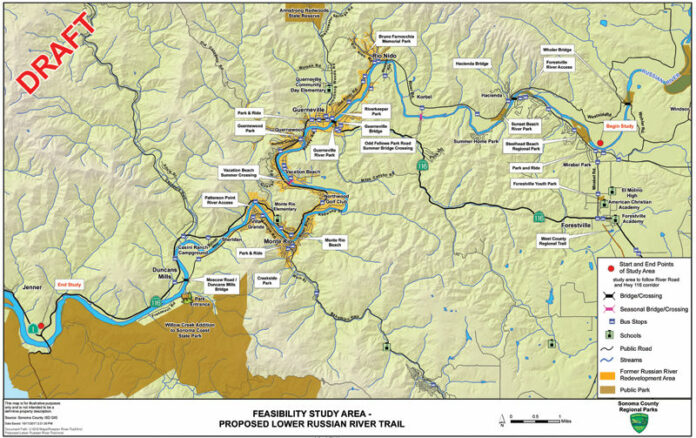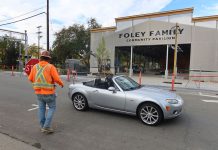On Oct. 23 the last of three planned workshops was held on a proposed 19.3 mile multi-use trail between Mirabel Park and Jenner. The high-speed River Road/Highway 116 corridor has a history of multiple pedestrian and bicycle accidents. The proposed trail is intended to provide a paved path separate from the roadway. The study’s stated goal “is to provide safe walking and bicycling access to communities, schools, businesses, parks and beaches, and other recreation opportunities along the river corridor.”
The evening workshop gave Some 50 lower Russian River attendees the opportunity to prioritize a long list of trail amenities and features, from car and bicycle parking, to picnic tables, restrooms, vista points, as well as logos and the style of trailside signage. Workshop participants were given stickers to post their votes on the study maps.
Present at the workshop on a low-profile basis were Fifth District Supervisor Lynda Hopkins and two members of the lower Russian Municipal Advisory Committee, Jeanette Dillman and Jennifer Wertz.
The proposed trail was shown running along the side of the roadway away from the Russian River. That drew negative comments from a number of participants, one of whom said, “We were looking for ways to get away from the road, not have the trail right on it.” Others asked that the trail at least include vistas enabling trail users to look down on the river.
One participant noted that the right of way for creation of the highway was much wider than the roadway itself, enabling incursion into private property along the corridor without requiring eminent domain action.
Sonoma County Regional Parks planner Ken Tam, chairman of the workshop, said the study’s staff was aware of the right of ways.
A major issue participants raised was homelessness, since the trail ultimately is expected to connect with the Joe Radota Trail all the way into Santa Rosa, where there has been heavy homeless occupancy. Tam said the proposed lower river trail would have a “no camping” policy. However, he said rules and regulations governing the trail were not a feature of the study.
Tam said the study’s findings will guide the draft trail proposal that will be submitted to the Board of Supervisors in late 2019 or early 2020. He declined to guess the ultimate cost of the trail and stressed that actual completion of the trail would take decades.
“We’ll have to go to the supes twice,” he said. “After they give us comments, next we have to find the money.”
The study was primarily funded by a $620,000 grant from the California Department of Transportation, with additional funding from other state and local agencies. The feasibility study launched in November 2018.
Find out more at sonomacounty.ca.gov/Parks/Planning/Lower-Russian-River-Trail/









